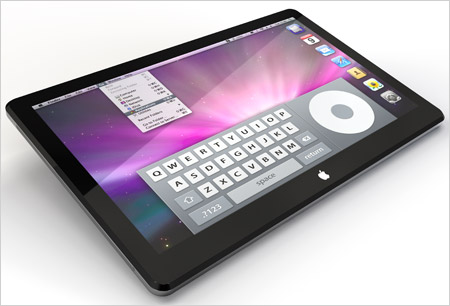 According to the Taiwan Economic News, the Californian-based tech giant Apple will launch its newest tablet PCs in February 2010. Apple Tablet boasts a few amazing and impressive features such as a 9.6-inch screen, finger-touch function and built-in HSPDA (high speed download packet access) module, and adopts a P.A. SEMI processor chip and long lasting battery pack. Its price ranges from US$799 to US$999 and surprisingly, the tablet may run on AT&T network.
According to the Taiwan Economic News, the Californian-based tech giant Apple will launch its newest tablet PCs in February 2010. Apple Tablet boasts a few amazing and impressive features such as a 9.6-inch screen, finger-touch function and built-in HSPDA (high speed download packet access) module, and adopts a P.A. SEMI processor chip and long lasting battery pack. Its price ranges from US$799 to US$999 and surprisingly, the tablet may run on AT&T network.
Few months back, rumors were saying Verizon is negotiating with Apple, to clinch a deal to host the Apple Tablet. It’s known that Verizon Wireless is to expedite the roll-out of its LTE network (also dubbed 4G), possibly in conjunction with the release of a new Apple device. However, with HSPDA (a feature that would give the tablet its 3G mobile connectivity) in hand, a Verizon/Apple tablet may not be a feasible idea. HSPDA obviously means it won’t work on Verizon’s CDMA/EVDO network, but it still might be possible for some kind of dual mode-functionality that allows LTE connectivity as well.
Currently, in the United States, only T-Mobile and AT&T use HSDPA for their 3G networks whereas Sprint and Verizon use EV-DO. There may be a possibility that the tablet will go to T-Mobile. However, some say AT&T would be the likely target since AT&T is already the exclusive U.S. carrier for the iPhone.
DynaPack International Technology Corp. has been exclusively contracted to supply up to 300,000 units of long lasting battery packs a month for Apple’s newest tablet PCs. In the meantime, Wanshih Electronic Co., Ltd., a leading supplier of PC mini coaxial cables in Taiwan, is expected to absorb around 70% of Apple`s orders for mini coaxial cables for the tablet PCs. Presently, Apple takes up nearly 50% of the company`s output as the most important client.
Also, Taiwan-based Mag. Layers Scientific-Technics Co., Ltd. and Wintek Corp. will supply power chokes and touch panels, respectively, for use in Apple`s newest tablet PCs. Noteworthy is that Wintek`s touch panels have been used in Apple`s iPhones for a while, while Mag. Layers has effectively squeezed into Apple`s power chock supplier list.